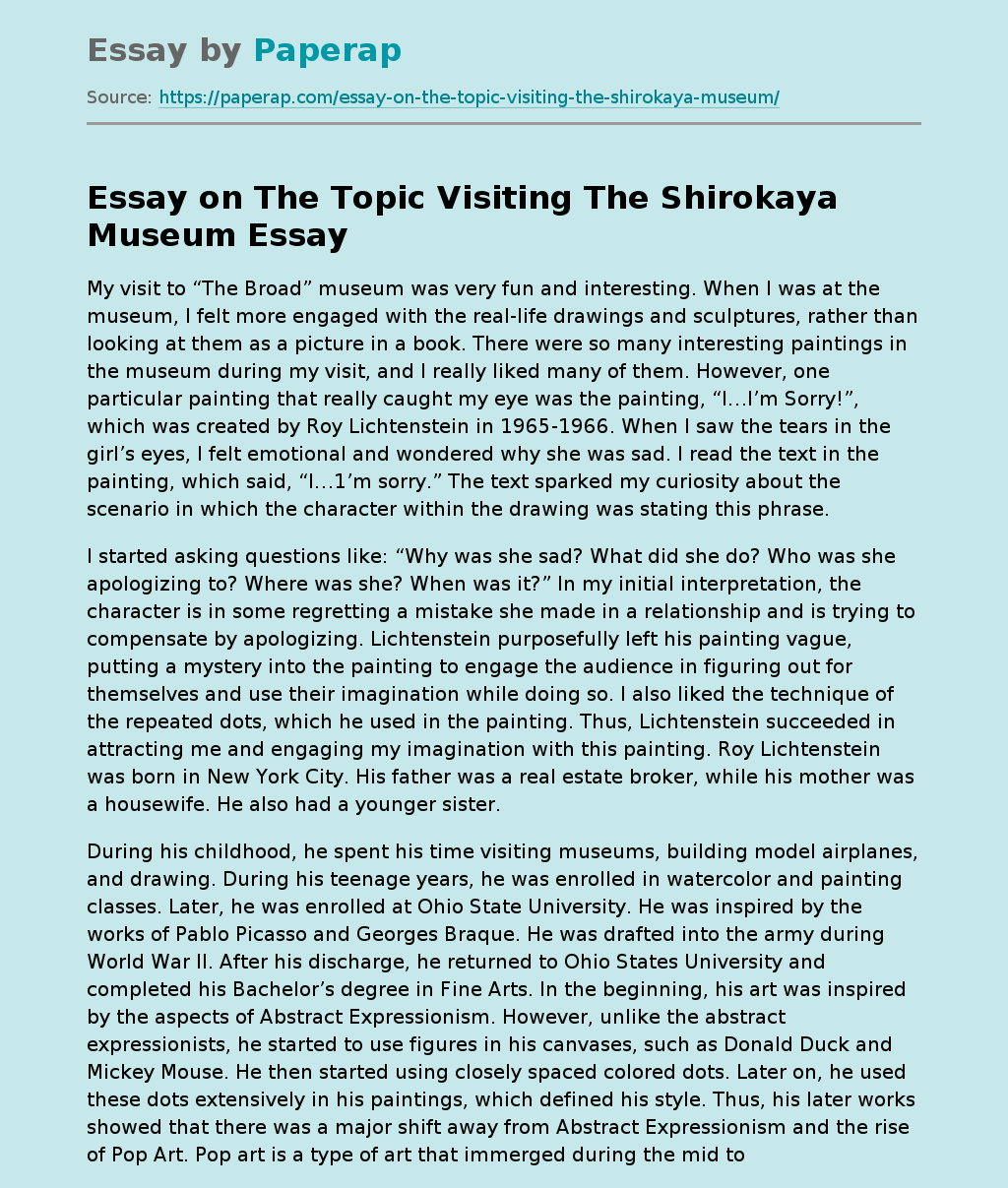My visit to “The Broad” museum was very fun and interesting. When I was at the museum, I felt more engaged with the real-life drawings and sculptures, rather than looking at them as a picture in a book. There were so many interesting paintings in the museum during my visit, and I really liked many of them. However, one particular painting that really caught my eye was the painting, “I…I’m Sorry!”, which was created by Roy Lichtenstein in 1965-1966.
When I saw the tears in the girl’s eyes, I felt emotional and wondered why she was sad. I read the text in the painting, which said, “I…1’m sorry.” The text sparked my curiosity about the scenario in which the character within the drawing was stating this phrase.
I started asking questions like: “Why was she sad? What did she do? Who was she apologizing to? Where was she? When was it?” In my initial interpretation, the character is in some regretting a mistake she made in a relationship and is trying to compensate by apologizing.
Lichtenstein purposefully left his painting vague, putting a mystery into the painting to engage the audience in figuring out for themselves and use their imagination while doing so. I also liked the technique of the repeated dots, which he used in the painting. Thus, Lichtenstein succeeded in attracting me and engaging my imagination with this painting. Roy Lichtenstein was born in New York City. His father was a real estate broker, while his mother was a housewife.
He also had a younger sister.
During his childhood, he spent his time visiting museums, building model airplanes, and drawing. During his teenage years, he was enrolled in watercolor and painting classes. Later, he was enrolled at Ohio State University. He was inspired by the works of Pablo Picasso and Georges Braque. He was drafted into the army during World War II. After his discharge, he returned to Ohio States University and completed his Bachelor’s degree in Fine Arts. In the beginning, his art was inspired by the aspects of Abstract Expressionism. However, unlike the abstract expressionists, he started to use figures in his canvases, such as Donald Duck and Mickey Mouse. He then started using closely spaced colored dots. Later on, he used these dots extensively in his paintings, which defined his style. Thus, his later works showed that there was a major shift away from Abstract Expressionism and the rise of Pop Art. Pop art is a type of art that immerged during the mid to late 1950s. Initially, the Pop art movement arose from the rebellion against Abstract Expressionism.
Short for “popular art,” this visual art movement was based on popular culture and the mass media. It is often referred to as “material culture,” since it uses objects that are easily recognizable and represent popular items, famous people, and common ideas. Some of the common characteristics include recognizable imagery, bright, and bold colors, clear lines, flat imagery, and celebrity images. This art could have been inspired by advertisements, comic books, newspapers, and magazines. The American artist Roy Lichtenstein was a leading figure of the Pop art movement, along with Andy Warhol and Jasper Johns. Lichtenstein started borrowing images from comic books and advertisements in the early 1960s. After borrowing the image, he crops the original image and even changes the dialogue. He then copying the image by hand, then enlarges this copy on the canvas using a projector.
Lastly, he traces the outlines onto the canvas in black and fills the images with primary colors or repeating dots, known as Ben-Day dots. The Ben-Day dots printing process is Lichtenstein’s trademark since they are seen in most of his work. However, Lichtenstein did not paint every dot by hand. He used different perforated stencils and painted over them. Thus, the paint seeps through holes, creating perfect circles. In the painting, “I…I’m Sorry!” Lichtenstein used oil and Magna on the canvas while drawing it (museum label). This technique that he used blended both aspects of hand-drawing and mechanical reproduction. In doing so, he transformed commercial images from comics and advertisements into art, where people can observe and appreciate. Observing and studying this painting, it impacted me a lot because it has a lot of meanings. It is designed for you to use your imagination to tell the story behind the painting.
How about: Enjoyable and Stimulating Visit to The Broad Museum?. (2021, Dec 14). Retrieved from https://paperap.com/essay-on-the-topic-visiting-the-shirokaya-museum/

